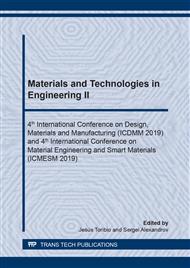[1]
A. Bahari, J. Berenjian, A. Sadeghi-Nik:Modification of Portland cement with Nano SiC. Proceedings of the National Academy of Sciences India Section A - Physical Sciences, Vol (86), Issue 3, pp.323-331, (2016).
DOI: 10.1007/s40010-015-0244-y
Google Scholar
[2]
A. Bahari, A. Sadeghi-Nik, M. Roodbari, E. Mirshafiei, B. Amiri: Effect of Silicon Carbide Nano Dispersion on the Mechanical and Nano Structural Properties of Cement. National Academy Science Letters, Vol (38), Issue 4, pp.361-364, (2015).
DOI: 10.1007/s40009-014-0316-6
Google Scholar
[3]
R. Pernicova: Possibility of using recycled raw materials (Corundum and silicon carbide) in cementitious mixtures, Proceedings of 7th International Conference on Mechanics and Materials in Design (M2D), Portugal, pp.679-680, (2017).
Google Scholar
[4]
J.J. Brooks: Influence of mix proportions, plasticizers and superplasticizers on creep and drying shrinkage of concrete. Magazine of concrete research, Vol (41), Issue 148, pp.145-153, (1989).
DOI: 10.1680/macr.1989.41.148.145
Google Scholar
[5]
D. Nagrockiene, I. Pundiene, A. Kicaite: The effect of cement type and plasticizer addition on concrete properties. Construction and building materials, Vol (45), Issue 6, pp.324-331, (2013).
DOI: 10.1016/j.conbuildmat.2013.03.076
Google Scholar
[6]
H.Y. Aruntas, S. Cemalgil, O. Simsek: Effects of super plasticizer and curing conditions on properties of concrete with and without fiber. Materials letters, Vol (62), Issue 19, pp.3441-3443, (2008).
DOI: 10.1016/j.matlet.2008.02.064
Google Scholar
[7]
J. Hruza, Z. Prosek: The effect of plasticizer on mechanical properties of the cement paste with fine ground recycled concrete. Nano & Macro mechanics 2017, Acta Polytechnica CTU, Vol (13), pp.61-65, (2017).
DOI: 10.14311/app.2017.13.0061
Google Scholar
[8]
L. Dvorkin, O. Dvorkin, Y. Ribakov at al.: Using Granite Siftings for Producing Vibro-Pressed Fine-Grained Concrete. KCCE Journal of civil Engineering, Vol (21), Issue 6, pp.2252-2258, (2017).
DOI: 10.1007/s12205-017-1034-7
Google Scholar
[9]
R.Pernicova, T. Kolomaznik: Wholeness of briquettes made from recycled silicon carbide during handling in early stage, International Multidisciplinary Scientific GeoConference Surveying Geology and Mining Ecology Management, SGEM, Vol 18(4.2), pp.259-264, (2018).
DOI: 10.5593/sgem2018/4.2/s18.034
Google Scholar
[10]
G.J. Campisi: Status of silicon carbide power technology, Power Engineering Society, Summer Meeting, Vol (2), pp.1238-1239, (2000).
DOI: 10.1109/pess.2000.867558
Google Scholar
[11]
Metallurgy, KOLTEX COLOR s.r.o, Retrieved April 29, 2019 from http://www.koltex.cz/english/metallurgy.htm.
Google Scholar


